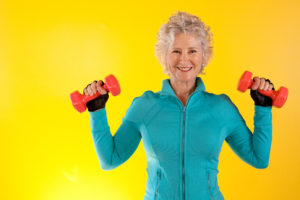1st Priority: Learn to Move Safely
When first diagnosed with bone loss, people often want to jump into a bone-strengthening exercise program, ASAP! While it’s a good idea to pursue weight bearing and muscle strengthening exercise, it’s even more important to find the ways you might already be putting your spine at risk during your day to day life.
I’m often asked, what is the most important exercise for healthy bones? My answer is first and foremost, always keep good body alignment in all your daily movements. Standing tall will help develop your posture muscles.
What is good body alignment?
Avoid the following positions or movements to keep proper alignment:
• A slumped, head-forward posture
• Bending forward from the waist (or upper back)
• Twisting of the spine to a point of strain
• Twisting the trunk and bending forward when doing activities such as coughing, sneezing, vacuuming or lifting
• Anything that requires you to reach far. An example is reaching up for an item on a high shelf, which also could cause you to lose your balance and fall.
• Some exercises can do more harm than good. If you have osteoporosis or have had broken bones in the spine, you should avoid exercises that involve bending over from the waist.
—From NOF’s “Proper Body Alignment” article.
Fixing your body alignment will take some detective work as you go through your day. From tying your shoes to getting a file from a lower drawer or putting heavy bags into your car, you’ll find several times a day when your spine is at risk because of a forward bend. The precautions above are recommended whether you are in the low bone density range or have been diagnosed with osteoporosis.
Why Not Bend Forward?
The reason we don’t want to bend forward and put more pressure on the front part of our spine is because it’s weaker than the back part. Keeping a neutral spine with the pressure off the front side is one way to significantly reduce your risk of fracture. Developing the muscle memory of consistently keeping good body alignment with a neutral spine is worth the effort! As the years go by, our risk of fracture increases and this muscle memory will help you automatically move safely.
What is a Neutral Spine?
A neutral spine is your most upright, elongated, best posture. You can think of it as keeping a flat, not rounded back. But there are still the normal curves of the spine which look a bit different on all of us–in a little below the head, out a little at the upper back, in a little at the waist, and out a bit at the sacrum or tailbone.
Daily Posture Check
I encourage my class participants to check their posture against a wall daily like this:
- Touch the back of your head, shoulder blades, and tailbone against the wall.
- Your feet don’t need to be all the way against the wall because we all have different derriere sizes!
- Don’t strain if your head doesn’t touch the wall, but stand as elongated and tall as possible with your chin level to the floor.
- Now, walk away from the wall and come back to see if you’ve held the position.
Most people feel like robots at first because they’re not used to being so upright. Also, by the time they’ve walked around for 30 seconds, they’ve begun to slouch again. Do this wall posture check numerous times a day to build the habit of great posture.
If your back muscles get tired while sitting upright, use pillows behind your back for support while you’re building good posture. If you stick with it, you’ll be rewarded with stronger back muscles and beautiful posture.
Take Time to Practice the Hip Hinge
Instead of rounding over when you need to lower down, do the “hip hinge.” This is definitely a move that requires you to stick your buttocks back and takes time and practice to learn. It’s reversing the rule most women learned decades ago, to “Sit like a lady!,” which causes us to tuck our hips under, letting our knees go forward, and rounding our backs.
A good test to see if you’re rounding your back is to put a dowel or broomstick at the back of your head, upper back, and tailbone. Then, hinge back with your hips as you lower down, keeping your chest up, knees behind the toes, and the dowel in contact with those points. When it begins to lift off any point, you’re beginning to round. With kyphosis, you might not be able to touch all three points when upright, but simply use the dowel as a reference for your most upright posture.
Requesting a referral from your healthcare provider to a physical therapist (PT) is an ideal way to learn these moves. The one-on-one instruction a PT provides can get you off to an excellent start.
Move Safely
If you’ve received a bone loss diagnosis, moving with a neutral spine from the moment you leave your doctor’s office will help avoid fractures. It may feel awkward at first, but moving like this will also help protect your intervertebral discs, the soft cushions between the vertebrae. Once you have these bone-safe movement patterns established; then look into taking that bone-strengthening exercise class! But call ahead to make sure that it’s adapted to be bone-safe. Move safely and do no harm!

Susie is a personal trainer, certified by the American College of Sports Medicine, and physical education teacher. She teaches strength training class for women over 50. Susie has produced two exercise DVDs; Safe Strength Training for Osteoporosis Prevention and Resistance Training for Osteoporosis Prevention. She also writes a blog and newsletter, Motivation to Move for Healthy Bones, at SusieHathaway.com and answers exercise questions as a volunteer moderator on the NOF online support community.